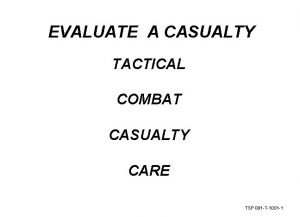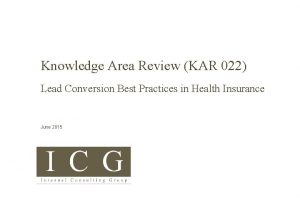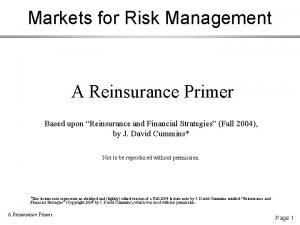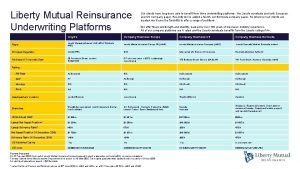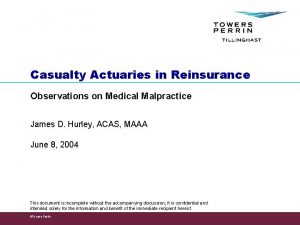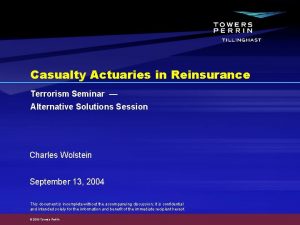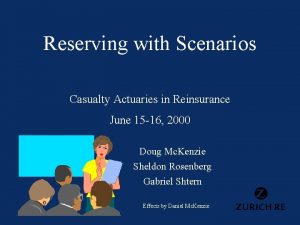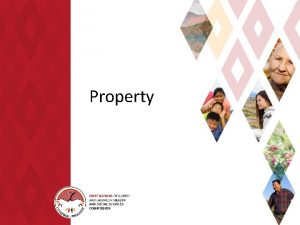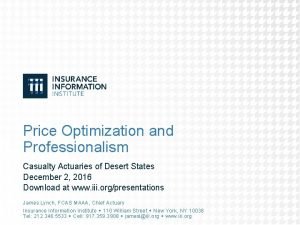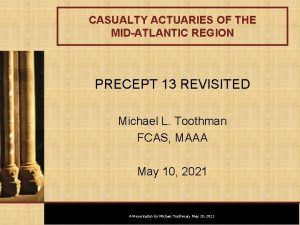Casualty Actuaries in Reinsurance Property Per Risk Reinsurance































- Slides: 31

Casualty Actuaries in Reinsurance Property Per Risk Reinsurance Glenn Meyers Insurance Services Office, Inc. June 2 -3, 2003

ISO’s PSOLD Product Underlying data – Commercial property claims reported to ISO during 1991 -2000 Separate mixed exponential curves fit by: – – Amount of insurance groups Occupancy group Subline Coverage (Building, Contents, Building + Contents, All Causes of Loss) Previously discussed 2000 CARe meeting http: //www. casact. org/coneduc/reinsure/2000/handouts/meyers 1. ppt Will not repeat the entire presentation here Talk about demographic features

Sample Input for AOI Ranges

Sample Input for State and Occupancy

The Mixed Exponential Size of Loss Distribution i’s vary by subline and coverage wi’s vary by AOI and occupancy group in addition to subline and coverage

The Mixed Exponential Size of Loss Distribution i = mean of the ith exponential distribution For higher i’s, a higher severity class will tend to have higher wi’s.

The Classification Data Availability Problem Focus on Reinsurance Treaties – Primary insurers report data in bulk to reinsurers – Property values in building size ranges – Some classification, state and deductible information Reinsurers can use ISO demographic information to estimate effect of unreported data.

Thought Experiment Consider a database with – – Amount of Insurance - AOI State Occupancy Group Loss Amount Select records that satisfy criteria – e. g. – – – AOI between X and Y State = Tennessee Apartments Construct empirical size of loss distribution Credibility problems

Database Behind PSOLD 120, 000+ records (for each coverage/line combination) containing: Severity model parameters Amount of insurance group – 60 AOI groups Occupancy class group State Number of claims applicable to the record

Constructing a Size of Loss Distribution Consistent with Available Data Using ISO Demographic Data Select relevant data Selection criteria can include: – Occupancy Class Group(s) – Amount of Insurance Range(s) – State(s) Supply premium for each selection Each state has different AOI and occupancy/class demographics

Constructing a Size of Loss Distribution for a “Selection” Record output - Layer Average Severity Combine all records in selection: LASSelection = Wt Average(LASRecords) Use the record’s claim count as weights

Constructing a Size of Loss Distribution for a “Selection” Where: i = ith overall weight parameter wij = ith weight parameter for the jth record Cj = Claim weight for the jth record

Case 1 – Very Limited Information All occupancy classes All amounts of insurance All states Case 2 – State Information All occupancy classes All amounts of insurance Tennessee only

Differences due to state demographics by occupancy and AOI

The Combined Size of Loss Distribution for Several “Selections” Claim Weights for a “selection” are proportional to Premium Claim Severity LASCombined = Wt Average(LASSelection) Using the “selection” total claim weights The definition of a “selection” is flexible

The Combined Size of Loss Distribution for Several “Selections” Calculate i’s for groups for which you have pure premium information. Calculate the average severity for jth group

The Combined Size of Loss Distribution for Several “Selections” Calculate the group claim weights Calculate the weights for the treaty size of loss distribution

Case 1 – Very Limited Information All occupancy classes All amounts of insurance All states Case 3 – AOI Information All occupancy classes Different AOI Groups – 50% under $250 K – 30% between $250 K and $500 K – 20% over $500 K All States

Differences due to more specific AOI information

Sample Input for AOI Ranges Put in a lot of selections PSOLD demographics fill in within the selections

Sample Input for State and Occupancy Can specify state and class within each selection

The Deductible Problem Most property insurance is sold with a deductible – A lot of different deductibles PSOLD has ground up size of loss distribution as well as size of loss distributions net of deductibles

Size of Loss Distributions Net of Deductibles Combine over all deductibles LASCombined Post Deductible Equals Wt Average(LASSpecific Deductible) Weights are the number of claims over each deductible.

Size of Loss Distributions Net of Deductibles For an exponential distribution: Net severity Need only adjust frequency -- i. e. wi’s

Adjusting the wi’s Dj jth deductible amount ij Wi = Weighted Average gij’s

Case 4 = Case 1 Ground Up

Summary PSOLD allows you to use whatever information you do have – Amount of insurance (limits profile) – Occupancy class group – State – Deductible PSOLD demographic information provides a default to use when you do not get information on reinsurance treaties.

A Major Departure from Traditional Property Size of Loss Tabulations Tabulate by dollars of insured value Traditionally, property size of loss distributions have been tabulated by % of insured value.

Fitted $ Average Severity against Insured Value

Fitted Average Severity as % of Insured Value Blow up this area

Fitted Average Severity as % of Insured Value Eventually, assuming that loss distributions based on a percentage of AOI will produce layer costs that are too high.
 Finite risk reinsurance
Finite risk reinsurance Conrad siegel 401k
Conrad siegel 401k International association of black actuaries
International association of black actuaries Actuaries act 2006
Actuaries act 2006 Student actuaries at michigan
Student actuaries at michigan Akhtar & hasan actuaries
Akhtar & hasan actuaries Credit risk market risk operational risk
Credit risk market risk operational risk Evaluate a casualty
Evaluate a casualty Combat casualty assessment
Combat casualty assessment How did the minie-ball affect the casualty rate of the war?
How did the minie-ball affect the casualty rate of the war? California casualty claims
California casualty claims Task conditions and standards
Task conditions and standards Casualty notification officer training
Casualty notification officer training Mass casualty triage guidelines
Mass casualty triage guidelines Tactical combat casualty care
Tactical combat casualty care How will you open the casualty's airway
How will you open the casualty's airway Pgmdt
Pgmdt Commutative property vs associative property
Commutative property vs associative property Sapratibandha
Sapratibandha Physical property and chemical property
Physical property and chemical property Treaty reinsurance
Treaty reinsurance Types of reinsurance
Types of reinsurance Facultative reinsurance
Facultative reinsurance Facultative reinsurance
Facultative reinsurance Facultative
Facultative Sava re slovenia
Sava re slovenia Milli re
Milli re Lockstep
Lockstep Reinsurance in a relationship
Reinsurance in a relationship Retroactive reinsurance accounting
Retroactive reinsurance accounting Reinsurance primer
Reinsurance primer Reinsurance mutual funds
Reinsurance mutual funds







